Reimagining Professional Development
INNOVATIVE LEADER AWARD WINNER - Education leaders at Laguna Beach USD have implemented a new approach to professional development
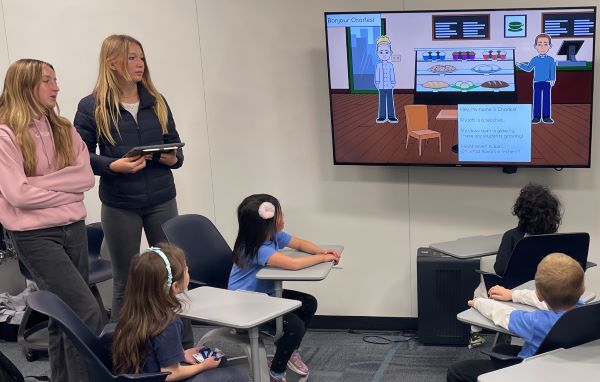
Have you ever heard a student say:
- Why do I need to learn this?
- How does this apply to the real world?
- When am I ever going to need these skills?
Laguna Beach USD listened and constructed a three-day Unit Design professional development workshop that challenged teachers to tackle these questions by creating engaging and relevant units to take students' learning to the next level.
“We wanted teachers to be exposed to the best teaching strategies while giving them time for collaboration and feedback with teachers district-wide,” said Mike Morrison, co-leader of the workshop. Many parts of the workshop allowed elementary and secondary school teachers to partner together to brainstorm ideas and refine their units.
Reimagining Professional Development: Building Conceptual Understanding
To reimagine the PD, a math teacher took a traditional 3D geometry unit and changed the standards-based goal into a relevant driving question: How can you use surface area and volume to reduce waste in consumerism?
Three-dimensional geometry is typically a unit focused on procedure and plug-and-chug problems, however, through the redesign, students were placed back at the center of the learning experience with hands-on projects that create deeper understanding of three-dimensional geometry by making connections and applying it to real-world scenarios.
In this unit redesign, students evaluated the efficiency of packaging on their favorite products to determine if there is a more sustainable alternative while answering the question: Is there a way to maintain the volume of a shape while reducing its surface area?
Student choice was a focus of reimagining authentic assessments, therefore, students were able to choose from four options as to how they wanted to demonstrate their learning:
Tools and ideas to transform education. Sign up below.
- Write to the CEO of the company and explain the changes necessary to make their product use less packaging.
- Design a working model of the new packaging that is more efficient.
- Present a Google slideshow.
- Create a Flipgrid video.
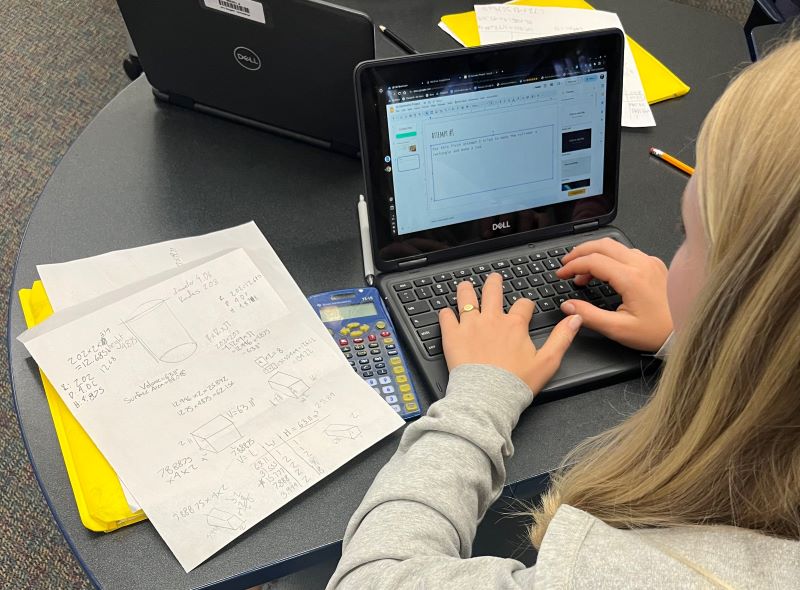
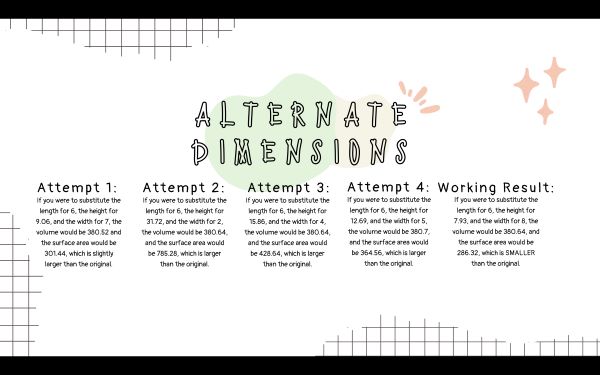
This workshop moved math teachers from an emphasis on computational processes to a focus on building conceptual understanding. Teachers from all grade levels and subjects were challenged to explore real-world problem-solving but described the journey of creating new units as rewarding.
Reimagined Impact/Benefit
The way the workshop was designed had a lasting impact on teachers and their practices. Teachers found the new and reimagined teaching strategies explored in redesigning the units were contagious to other units taught throughout the year.
“My unit had some EduProtocol signature practices embedded in it,” said teacher Scott Wittkop. “The unit gave me time to try them out and see their effectiveness. Now I am applying these teaching strategies to other lessons.”
One of the focuses in redesigning the units through the lens of essential questions created numerous opportunities for cross-curricular integration and collaboration amongst different grade levels, school sites, subject areas, and student populations. This multi-dimensional collaboration further strengthened the community of teachers and staff in LBUSD and provided more authentic learning opportunities for the students.
“By collaborating with the kindergarten teachers in our district, I could present my students with an authentic purpose and an authentic audience for their writing,” said Sarah Benson, a high school English teacher. “My students were not simply memorizing terms for a test, but they were writing and creating a product that utilized their newly acquired knowledge and skills. The bonus was the thoughtfulness and compassion displayed as the students interacted with the kindergartners and shared their impactful works with them.”
How LBUSD Inspired and Motivated Teacher Buy In
To promote enlistment for the Unit Design workshop, district administrators visited each site and asked:
Do you have a unit you would like to redesign?
The answer was always yes.
Why not work with a team to redesign your unit and get paid for it?
The results were 75% of teachers signed up for the first year over the course of three sessions and the creation of 140 new units.
Teachers were allowed to sign up for multiple sessions if they brought a co-teacher who hadn’t done unit redesign yet. This was LBUSD’s attempt at a multi-tiered marketing professional development system.
Inspiration Behind the PD
Over the past two years, LBUSD has been refining the portrait of a learner profile, which outlines the durable skills and SEL goals that are fostered in students. The learner profiles include Effective Communicator, Empowered Learner, Creative Problem Solver, Constructive Collaborator, and Empathetic Citizen, and provided teachers a solid lens to redesign their units.
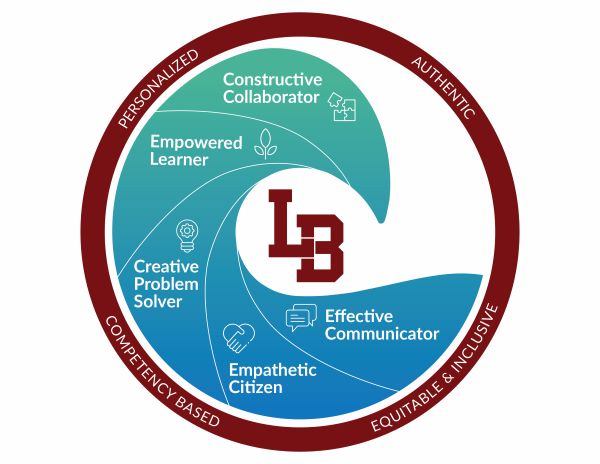
Durable skills are being adopted from nonprofit America Succeeds, which found common skills among 82 million job postings. While teachers seek to integrate these “portrait of a learner” competencies, they also focus on developing each of these areas.
LBUSD also adopted Dr. Sonny Magana’s T3 Framework for Innovation as another key lens for this workshop to improve student engagement and relevance. The T3 Framework is a research-based taxonomy that categorizes teaching strategies with technology from low to high impact in a clear and understandable structure.
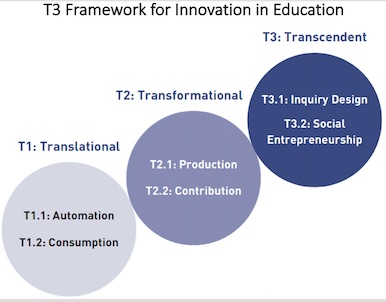
By combining the ideas from the T3 Framework and the sound, effective teaching strategies researched by Hattie, the district has compiled a list of signature practices for teachers to implement that have a high effect size on student learning. The goal of these practices is to get every student involved and cover multiple standards repeatedly so over time students nail the basics.
Implementing the PD
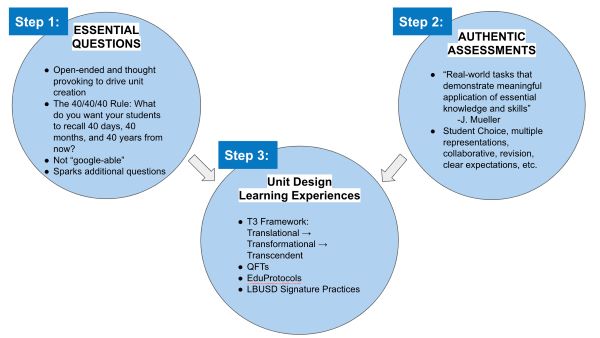
Essential questions were the key to redesigning the units and the workshop spent about 20% of the time working on essential questions, which unlocked the thinking for the rest of the unit.
By the end, all of the teachers felt more confident in the understanding of what an essential question is and how to construct one.
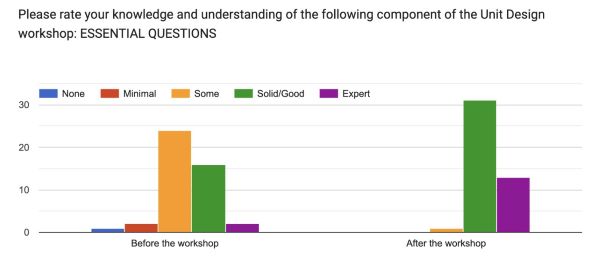
The workshop was framed around the ideas of the T3 Framework and implemented using the T3 learning strategies to help familiarize teachers with the framework. A balance of teaching sections and design sections were embedded throughout the workshop.
During the design sections, teachers used a template to record their ideas that had links to each of the components. This allowed for flexibility and participants could move ahead on their own if they finished the current section early or to go back at a later time and still have access to the resources discussed. The teaching sections were relatively short and the design sessions were two to four times longer. The purpose of the workshop was to give teachers time to work together to brainstorm ideas and think deeply about their units.
At the end of the unit design process, teachers shared work with a gallery walk presentation for which many administrators and board members were present. Here is an example of a slideshow from the gallery walk: Lesson Slideshow.
“The gallery walk allows us time to learn from each other’s work and celebrate our teachers’ success in designing relevant units,” said Dr. Chad Mabery, Assistant Superintendent of Curriculum and Instruction. “We love to see how proud the teachers are of this challenging and professional work.”
The final stage of this process is implementing the newly designed units in the classroom. Student feedback was gathered as part of the reflection process for teachers. Instructional coaches were paired-up with teachers to encourage and help with reflection on the student feedback and implementation.
Future Unit Design Projects
The base pay for this work is:
- Unit development (includes three-day workshop and planning): $1,200
- Unit completion & reflection (includes student feedback): $300
In addition to the base pay and to help support the district’s commitments of “relationship matters” and “continuous improvement,” teachers can opt into Unit Design enhancements to receive extra pay, including:
- Teaming internal (working cross curricular or cross grade level with LBUSD teacher): $200
- Teaming external (working with a teacher or community partner outside of LBUSD): $200
- Speaking at conference or writing an article: $600
- Achieving T3 Level Unit: $300
In future iterations of the Unit Design process leaders at LBUSD will analyze current teaching strategies based on effectiveness. Strategies that are ineffective can be removed and replaced with more effective ones. Future units will address meta-cognitive and meta-learning strategies.
LBUSD also aims to be transparent with students by including them in the design process, sharing why teachers are using certain strategies, and allowing them to pick learning strategies and habits that will help them achieve their learning goals.
"One of our LBUSD collective commitments is to continuously improve,” said Dr. Jason Viloria, LBUSD Superintendent. “We invite other districts to join us in creating relevant units."
To find out more about Unit Design in LBUSD, check the district webpage.
Michael Morrison was recently recognized for Best Example of Professional Development with a Tech & Learning Innovative Leader Award.
Michael Morrison is Chief Technology Officer for Laguna Beach USD in California. Lauren Anderson is a mathematics teacher at Laguna Beach USD.

